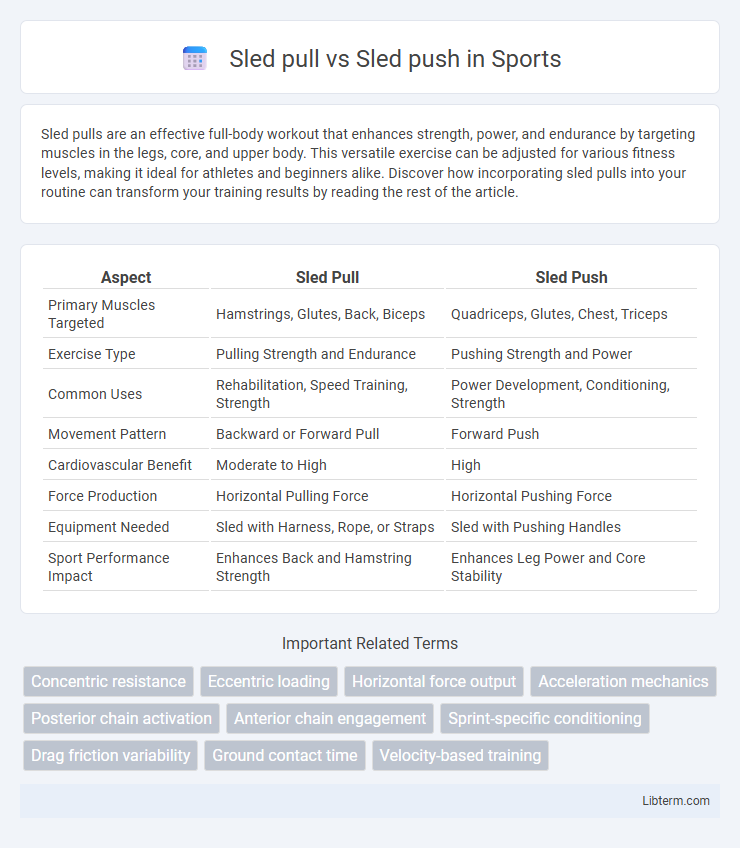Sled pulls are an effective full-body workout that enhances strength, power, and endurance by targeting muscles in the legs, core, and upper body. This versatile exercise can be adjusted for various fitness levels, making it ideal for athletes and beginners alike. Discover how incorporating sled pulls into your routine can transform your training results by reading the rest of the article.
Table of Comparison
| Aspect | Sled Pull | Sled Push |
|---|---|---|
| Primary Muscles Targeted | Hamstrings, Glutes, Back, Biceps | Quadriceps, Glutes, Chest, Triceps |
| Exercise Type | Pulling Strength and Endurance | Pushing Strength and Power |
| Common Uses | Rehabilitation, Speed Training, Strength | Power Development, Conditioning, Strength |
| Movement Pattern | Backward or Forward Pull | Forward Push |
| Cardiovascular Benefit | Moderate to High | High |
| Force Production | Horizontal Pulling Force | Horizontal Pushing Force |
| Equipment Needed | Sled with Harness, Rope, or Straps | Sled with Pushing Handles |
| Sport Performance Impact | Enhances Back and Hamstring Strength | Enhances Leg Power and Core Stability |
Introduction to Sled Pull and Sled Push
Sled pull and sled push are dynamic resistance training exercises targeting strength and power development, primarily involving the lower body, core, and upper body muscles. Sled pull emphasizes posterior chain activation including hamstrings, glutes, and back muscles, enhancing grip strength and acceleration mechanics. Sled push focuses on explosive force generation from the quadriceps, calves, and core, improving sprint performance and overall muscular endurance.
Key Differences Between Sled Pull and Sled Push
Sled pull exercises emphasize eccentric muscle activation and involve pulling a weighted sled towards the body, targeting the hamstrings, glutes, and posterior chain with a focus on controlled resistance. Sled push exercises concentrate on concentric force production by driving the sled forward, engaging the quadriceps, calves, and core muscles, prioritizing explosive power and speed. Both movements enhance strength and conditioning but differ in muscle emphasis, movement mechanics, and specific athletic performance benefits.
Muscles Targeted: Sled Pull vs Sled Push
Sled pull primarily targets the posterior chain, including the hamstrings, glutes, calves, and lower back muscles, while also engaging the biceps and forearms for grip strength. Sled push emphasizes the quadriceps, glutes, and calves, with significant activation of the core and shoulder stabilizers to maintain posture and drive force. Both exercises improve muscular endurance and power but differ in muscle activation patterns due to the pulling versus pushing mechanics.
Benefits of Sled Pull Training
Sled pull training enhances posterior chain strength by targeting muscles such as the hamstrings, glutes, and lower back more effectively than sled push exercises. This form of resistance training improves grip strength, coordination, and cardiovascular endurance, making it integral for athletes requiring explosive power and injury prevention. Incorporating sled pulls into workout routines promotes balanced muscle development and functional movement patterns critical for sprinting and agility.
Advantages of Sled Push Workouts
Sled push workouts enhance overall power and endurance by engaging multiple muscle groups including the quadriceps, glutes, and core, promoting functional strength and athletic performance. They impose less strain on the lower back compared to sled pulls, reducing injury risk while improving cardiovascular fitness through high-intensity interval training. This exercise also encourages better posture and biomechanical efficiency, making it ideal for rehabilitation and sport-specific conditioning.
Sled Pull for Speed and Acceleration
Sled pull exercises significantly enhance speed and acceleration by targeting the posterior chain muscles, including the hamstrings, glutes, and lower back, crucial for explosive power. This resistance training improves neuromuscular coordination and stride mechanics, directly contributing to faster sprint times. Compared to sled pushes, sled pulls allow for greater load variation and mimic the natural sprinting motion, making them more effective for developing rapid acceleration.
Sled Push for Power and Strength
Sled push exercises primarily target the quadriceps, glutes, and calves, making them highly effective for building lower body power and strength. The forward driving motion of a sled push recruits fast-twitch muscle fibers, enhancing explosive force and overall athletic performance. Compared to sled pulls, sled pushes allow for greater load capacity and duration, optimizing strength gains through increased muscular tension and cardiovascular demand.
Common Mistakes to Avoid
Sled pull and sled push exercises often suffer from common mistakes such as improper body positioning and incorrect foot placement, which reduce effectiveness and increase injury risk. Maintaining a neutral spine, engaging the core, and avoiding excessive forward lean during sled pulls are essential to optimize force production and protect the lower back. During sled pushes, keeping elbows locked, driving through the heels, and ensuring controlled, steady steps prevent inefficient movement patterns and joint strain.
Which Variation Is Best for Your Fitness Goals?
Sled pull exercises primarily target the posterior chain, including the hamstrings, glutes, and back muscles, making them ideal for improving strength and muscle endurance in these areas. Sled push variations emphasize the quadriceps, calves, and core stability, benefiting overall power development and athletic performance. Choose sled pull for enhanced posterior strength and injury prevention, while sled push is best for building explosive lower-body power and cardiovascular conditioning tailored to your fitness goals.
Sled Pull vs Sled Push: Final Comparison and Recommendations
Sled pull and sled push exercises target different muscle groups, with sled pulls emphasizing posterior chain muscles such as hamstrings, glutes, and back, while sled pushes primarily engage the quadriceps, calves, and core. In terms of conditioning, sled pushes tend to generate higher force output and can be more effective for building explosive strength, whereas sled pulls improve grip strength and enhance overall posterior chain endurance. For balanced athletic development, incorporating both sled pull and sled push workouts into training routines is recommended, adjusting load and distance based on specific performance goals.
Sled pull Infographic

 libterm.com
libterm.com